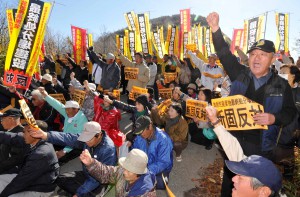Kozo Hikage

Farmers hold a sit-in in front of a candidate site for radioactive waste disposal in Kami, Miyagi Prefecture, to protest against the construction plan.
Farmers of Kami, Miyagi Prefecture, are strongly protesting against the government’s plan to construct in the town a final disposal site for high-level radioactive waste, including those collected from the disaster-hit Fukushima No. 1 nuclear power plant.
The Environment Ministry was scheduled to begin late last month a drilling survey at three locations in the prefecture including Kami, selected as candidate sites to store radioactive substances exceeding 8,000 becquerels per kilogram. But the surveying work was stalled in Kami amid demonstrations by residents.
The ministry hopes to end the survey by the end of this month before snow starts falling, but prospects are unclear as farmers insist that they will not yield an inch.
In January, the ministry selected three locations – state-owned lands in Tashirodake in the town of Kami, Fukayamadake in the city of Kurihara and Shimohara in the town of Taiwa – as the candidate sites to conduct detailed survey work for the final disposal of radioactive waste.
Although the three municipalities are all against the plan, local governments of Kurihara and Taiwa accepted the implementation of the survey work on condition that it will be conducted at the three locations at the same time. Meanwhile, the town of Kami rejected the survey and called on the ministry to cancel its selection of the town as a candidate site.
The government is expected to make the final decision on where to build a disposal site, based on discussions by an experts’ panel on the results of the survey.
“I lost quite a bit of weight since the beginning of this year, because the thought of the disposal site never gets out of my head,” said Inao Hayasaka, a 76-year-old farmer who owns 3 hectares of rice fields and eight breeding cows in Kami’s Sabusawa district close to the candidate site.
Hayasaka used to grow mushrooms on several thousands of bed logs, but after the March 2011 nuclear meltdown of the Fukushima plant, she was forced to refrain from marketing mushrooms and had to dispose of all the bed logs. She was filled with anxiety about how to make a living, when she heard the news that Tashirodake was chosen as one of the candidate sites for the final disposal of nuclear waste.
“I was suddenly put under a lot of emotional pressure,” she said. “I had a hard time with the nuclear accident, and now I have to cope with something that could have an influence on my children and grandchildren.”
Environment Ministry officials visited the site on Oct. 24, 25 and 27 to conduct a topography survey, but the survey was postponed as a group of some 80 people representing 46 agricultural and business organizations in the town stood by in protest.
Farmers are especially sensitive to the issue, because their businesses are already starting to be hit by harmful rumors. “Several customers tell us they cannot continue doing business with us if Kami is chosen (as the final disposal site),” said Shizuya Miura, head of JA Kami Yotsuba, an agricultural co-operative in Kami. Kami Mayor Hirobumi Inomata also said some companies, such as food processing firms, are beginning to consider moving their plants out of the town.
Farmers are not the only ones campaigning against the construction. Toshiyuki Konno, 62, had to close his construction firm in September because much of the workforce was taken by disaster reconstruction-related firms and he could not secure enough workers to receive construction orders.
“If agriculture, the key industry of the town, collapses, the town may not be able to survive,” he warned. “Young people will leave the town and it will become a ghost town.”
Farmers living close to temporary storage sites for radioactive waste have mixed feelings. A farmer in his 60s who lives about 100 meters away from a temporary storage site in the city of Tome, Miyagi, says he hopes the government will dispose of the waste on its own responsibility as soon as possible.
“Everyone is suffering,” says Hayasaka. “But we are not thinking of our own benefits. Our role is to make this place easier to live for our descendants.”
(Nov. 5, 2014)

